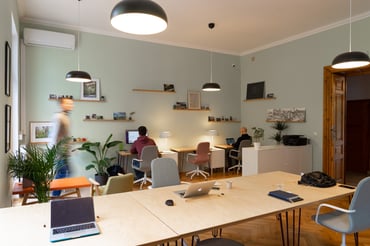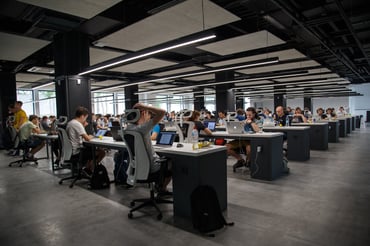How to define Continuous Improvement?
Small steps matter, especially when they’re all taken in the same direction. And there are plenty of examples of innovations that have made a difference – not through a sudden big bang but, instead, through a slow, continuous attack on a problem. Driving incremental improvements may seem like taking only small steps, but those small steps combined can add up to big change.
As the Scots used to say, “Many a mickle makes a muckle” – in other words, the small stuff adds up.
What do the Tour de France and continuous improvement have in common?
The Tour de France is a grueling race, with the competitors clawing their way up mountains, pounding along mile after mile of road – and all with the whirr of gears and the click of their competitors’ pedals in their ears. Winning the precious yellow jersey is a real feat each day – and managing to hold on to that lead through time trials, hill climbs, and general jostling with the others in the peloton before the final triumphant roll into Pairs is something else.
In 2012, Bradley Wiggins became the first Brit to win the Tour de France – and this feat was followed by an astonishing run of success by Chris Froome. Team Sky have won the Tour five times since then, only narrowly missing out in 2014. And the model is transferable – in 2012, Dave Brailsford (the man behind Team Sky) coached the British cycling team at the 2012 Olympic Games, dominating the competition and winning almost all the Gold medals available.
While Wiggins, Froome, and the rest of the team are dedicated athletes, there is something more – something that the team themselves acknowledge. It's a philosophy, a drive toward perfection in which the little things matter. Brailsford calls it the “marginal gains” model, basing it on the belief that a small improvement of 1% in every aspect of cycling adds up to a big performance gain.
The team started by focusing on the obvious elements – the training program, the nutrition regime, the cycle design and ergonomics, and the weight of the tires. But they went well beyond this, searching for improvements in areas overlooked by others – for example, finding the pillow that offered the best sleep and taking it with them to hotels, or teaching riders how to wash their hands to avoid infection.
Innovation through continuous improvement
Despite the obvious wisdom of continuous improvement, it’s often difficult to apply it to managing innovation. The reality is that behind every breakthrough is a long, grueling struggle with the small stuff. Most radical innovation is about a breakthrough idea and then a lot of sweating the small stuff, like debugging the software and working through modifications and adjustments.
For instance, Edison’s light bulb may have been a key moment in the history of illumination but it was the step-by-step incremental improvement that brought the cost down and the quality up to the point where it became a household item. And behind the scenes of the automobile revolution was the challenge of producing petroleum at the right quality – again the consequence of incremental innovation in refining the crude oil.
Synthetic fibers like rayon opened up a whole new world of fashion design and textile use – but it depended not just on breakthrough molecules but on incremental improvements to bring their cost down and their quality up.
Smartphones have appeared in our hands remarkably quickly – it’s only a decade since Apple launched the first iPhone and only 10 years before that when we switched from carrying “bricks” to handheld devices. To make that possible required enormous attention to detail, to drive down costs and push up performance.
Continuous improvement through the learning curve
We can think of continuous improvement in terms of learning curves – the idea that the more we make of something, the better we get at it. This observation originates from studies of airframe design in the 1930s, where improvements in both product and process emerged as volumes increased. Paying attention to the little learning opportunities for incremental innovation drives us along the learning curve.
Continuous improvement through a systematic approach
Just as we need to organize a project team to carry us forward to a breakthrough product, we also need to organize for incremental improvement. It only works when attention is focused on coordinating and directing everyone’s joint efforts, and where there is the motivation to contribute ideas, to suggest and challenge, and to build and share.
Continuous improvement through employees’ suggestions
We can see this collaborative approach to continuous improvement at work in the many long-running continuous improvement programs, visible in well-known examples like Toyota, and operating across the manufacturing and services sectors as well as in the public sector. These programs link two powerful principles – the idea that, if you ask them, employees will likely have many ideas for improvements and the notion of focusing problem-solving power on a key strategic target.

Across the other side of the world, in 1871, Denny’s shipyard in Dumbarton, Scotland began using suggestion boxes, inviting ideas for improvements. And in 1892, John Paterson, head of the National Cash Register company in the USA, began experimenting with ways of tapping into “the hundred-headed brain” of his workforce.
These days, such idea-generation schemes are everywhere – and they pay off.
When British Airways ran a campaign asking for suggestions for reducing fuel costs, around 200 ideas were sufficiently useful to be implemented. These included saving £600,000 a year by descaling the toilet pipes on its planes and making them lighter. Other ideas included replacing glass with plastic for wine bottles, reducing the volume of water tanks, washing engines more regularly, using lighter catering trolleys and cargo containers, and introducing lighter cutlery for business-class passengers. Overall, the savings so far have amounted to more than £20 million.
UK retail giant J Sainsbury has been running a similar campaign for many years, and one example in particular highlights the importance of small suggestions in making a difference. An employee noted that when the company ran a campaign selling mangoes at a discount, the packaging they came in only accommodated five mangoes. By repackaging the fruit into boxes of six, the company was able to save around £60,000 during the life of the campaign.
Continuous improvement through consistency
While one-off suggestions are all helpful, continuous improvement over a sustained period of time is essential. There are many examples – not least the “quality miracle” that Japanese industry first experienced during the 1970s. Here, a combination of mobilizing employees to contribute small suggestions – Kaizen – and a rigorous focus on quality significantly reduced defect rates from being measured in percentages to parts per million.
Similar stories relate to areas like plant maintenance and machine availability, or the relentless drive to reduce the time taken to set up large pieces of equipment like body presses in the car industry. A campaign spread over many years led to this time coming down from days to hours and eventually to single minutes – and the principle has been equally well applied in different fields, such as operating theatre set up and turnaround times at airports.Continuous improvement through high involvement
Studies of creativity show that when you ask a group of people to work on a problem, you generate not only more ideas but also more variety – more potential avenues to explore for solutions. In today’s era of crowdsourcing, we have the ability to spread the net widely when it comes to sourcing ideas. Organizations needs to consider the potential they have within their workforce – and ask whether or not they’re doing enough to tap into that rich well of potential innovation.
Continuous improvement through collaborative tools
Nowadays, the tools to enable collaborative incremental innovation are much more powerful than the simple suggestion box. Collaboration platforms can maximize the potential for team collaboration and crossover, idea enhancement, and knowledge capture. But they still depend on the same core principles as the suggestion box – a commitment to sustained incremental innovation as a way of gaining advantage and an enabling culture to engage employees as a key source of innovation.

Research on continuous improvement highlights a number of key essentials for achieving success:
- Continuous improvement (CI) should be seen as a core value – little improvements from everyone matter in an organization.
- Recognize and reward – this CI core value should be reinforced by relevant incentives (this is less about money than about being listened to, empowered, and enabled to contribute).
- Train and develop to support learning about how to be an effective continuous improvement innovator.
- Put in place a core process to enable continuous improvement to happen – including allowing time and space for it to operate.
- Utilize idea management systems to streamline idea generation and adoption.
- Leadership – encourage and enable entrepreneurial responsibility.
- Strategic direction – instigate a policy where bottom-up capability meets top-down clear direction about where and why improvements matter.
- Continuous improvement on continuous improvement – continuously review and update your CI approach.
.png?width=604&height=345&name=Untitled%20design%20(4).png)








